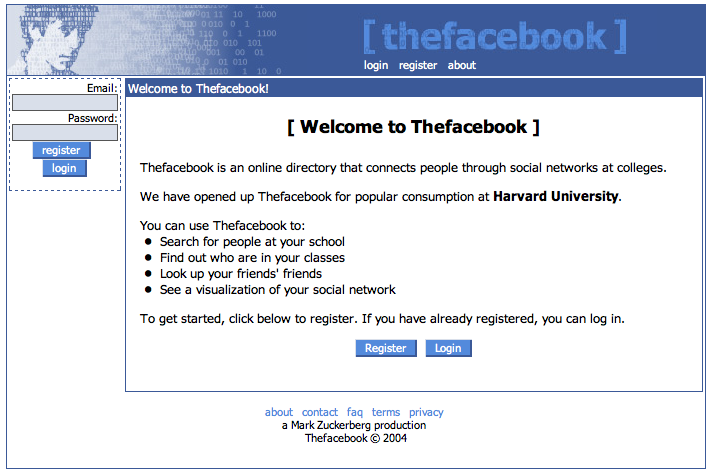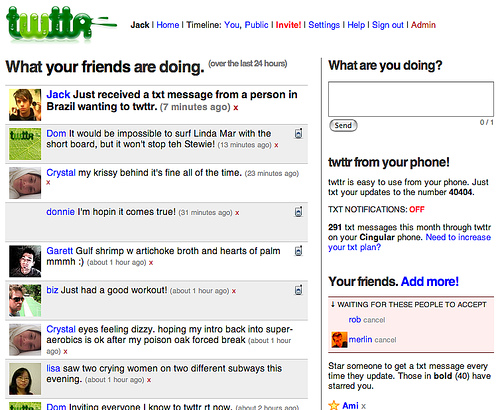When looking at some tech companies, it can be hard to imagine how they were in their early days. The success of each business is often dictated by their ability to get the fundamentals right. The software industry is unique in that it often doesn’t take much to create something that can offer so much potential, validate a range of ideas, and still provide the users with a working product.
Minimum Viable Products (MVPs) are often the beginning for many aspiring startups and entrepreneurs, and were the first pillar of success for many of the world’s largest Internet-based companies.
Due to the undisputed value MVPs add to the startup journey, it is not surprising to see that many companies that started out with an MVP have gone on to massive fame and fortune.
Here are five successful startups that started out with an MVP:
1. Facebook
While the original story of how Facebook began doesn’t start out like your normal MVP fairytale, it certainly ended that way.
How it Started
Before Facebook, there was Facemash, a website created by Mark Zuckerberg and three of his classmates (Andrew McCollum, Chris Hughes, and Dustin Moskovitz) while students at Harvard University. The concept of the website was simple – users would be shown two pictures of students side-by-side and would have to choose which student was hot and which one was not.
Now, I know what you are thinking – that’s a billion-dollar idea right there.
Unfortunately, the idea never came to fruition for Zuckerberg and friends, as they hacked Harvard servers and stole pictures of students from the university’s facebooks (books that displayed a photo of every new student at Harvard) so he could use them on his Facemash website. Unsurprisingly, the website was shut down by Harvard executives a few days after it’s release and Zuckerberg faced a string of charges (violating copyrights, breach of security, and violating individual privacy, etc.).
The website later went on to be sold for $30,201 – small change compared to most tech acquisitions these days.
The MVP
January 2004 saw the start of what is now known today as Facebook, although back then it was called Thefacebook and lacked a number of services that are included today.

Mark Zuckerberg originally created the application as a universal directory (or facebook, as it is known at Harvard) for students at Harvard University. In the beginning, membership to the site was restricted to Harvard students. The increase in its popularity meant that expansion to other universities was inevitable, so just a few months after its release, Thefacebook was rolled out to three other top American universities – Stanford, Columbia, and Yale.
The expansion to additional schools continued throughout 2005, but now included universities in the United Kingdom, Mexico, Puerto Rico, Australia, and New Zealand, as well as over 25,000 high schools located in various countries. The year also saw Thefacebook become just Facebook, after the company purchased the domain facebook.com for $200,000.
On September 26, 2006, Facebook opened its services to everyone with a valid email address aged 13 years or older. This was the official start of the Facebook we know and use today.
Investments
As you can imagine, Facebook has received a number of lucrative investment rounds, the most important including:
- First Angel investment (Series A): $500,000 in the summer of 2004.
- Series B: $12.7 million in April 2005.
- Series C: $27.5 million in April 2006.
- Series D: $240 million in October 2007.
On February 1, 2012, Facebook went on to file an initial public offering (IPO), aiming to raise $5 billion with an initial price of $38.00 per share. The IPO ended up raising $16 billion.
Keys to the MVP’s Success
Facebook’s early days displayed many key elements of a successful MVP, and these, along with a unique idea and a number of smart business moves, have resulted in Facebook becoming the success it is today. Here are some of the main MVP elements:
- Zuckerberg built a basic model of his product that contained only the required functionalities needed to fulfill its goal. Many of Facebook’s current functionalities weren’t included in the first release.
- The application was released to a small group of early adopters (users) in order to test the application and gain feedback.
Where Facebook is Now
Facebook is the most popular application on the Internet. Everyone knows this social network, but here are a few numbers to help put their success into perspective:
- Facebook has over 1.3 billion active monthly users. That’s just shy of China’s population (1.35 billion) and more than India’s population of 1.252 billion.
- It hit a milestone in 2014 by ending the year with $12.47 billion in revenue – an increase of 58% year over year.
- Facebook’s share price has increase from $38.00 per share at the IPO to $74.00 a share currently.
We Can Help You Build an AdTech Platform
Our AdTech development teams can work with you to design, build, and maintain a custom-built AdTech platform for any programmatic advertising channel.
2. Twitter
What was originally called twttr is the 140-character social network responsible for the invention of the #hashtag.
How It Started
Back in March of 2006, four board members (Jack Dorsey, Evan Williams, Biz Stone, and Noah Glass) of Odeo, a podcasting company, came up with an idea of developing an SMS service that would allow a person to communicate with a small group of people.
The MVP
The original Twitter prototype was designed for internal users at Odeo as a way to send messages to other employees and view them on a group level. After the initial internal testing, Twitter was released to the public on July 15, 2006.
Twitter’s real success came when it was featured in the South by Southwest Interactive conference in 2007. The social networking platform saw an increase in tweets during the event from 20,000 a day to 60,000. After the conference, Twitter’s popularity and its user base increased rapidly.

Investments
Twitter received a total of eight investment rounds before going public in 2013. Here are some of its earlier investments:
- Series A: $5 million on July 1, 2007.
- Series B: $15 million on May 1, 2008.
- Series C: $35 million on February 13, 2009.
- Series D: $100 million on September 25, 2009.
Twitter went public on November 7, 2013. The original share price jumped from $26.00 to $44.90 a share on its first day on the stock exchange, leaving Twitter with a market capitalization of $26.46 billion.
Key’s to the MVP’s Success
- Twitter was released to a small group of people for testing and gaining feedback.
- Many of the features Twitter encompasses now were not included in the first few releases, allowing the platform to focus on its initial goal.
Where Twitter is Now
Twitter has become the second most-popular social-networking tool in the word, behind Facebook.
- Over 284 million monthly-active users.
- Twitter’s share price has risen from its starting price of $26.00 to $39.00 a share.
3. Dropbox
Dropbox could have been an integral part of Apple’s iCloud, but instead of selling his company off just two years in to one of the world’s biggest companies, Drew Houston decided to grow his company privately and had to politely squash Steve Jobs’ hopes of an acquisition.
How Dropbox Started
Drew noticed that even though there were a lot of cloud-storage services on the market, many of them came with annoying problems. He wanted to create a service that would offer users a safe and secure storage solution focusing on simplicity.
The MVP
From the very beginning, Dropbox followed many of the fundamental techniques used when building an MVP. One of the key principles of building an MVP is to start off small and capture users’ interest early, and Dropbox did just that. Before even placing a working product into the hands of users, the team created a 30-second video that visually demonstrated their product.
The video was released to Dropbox’s target market on Hacker News in April 2007 and received thousands of comments and feedback from intrigued people. Through the use of a landing page, Dropbox captured over 70,000 email addresses of interested future customers.
This early customer research enabled the Dropbox team to validate their ideas and confirm that there was market demand for their product. Based on this initial feedback, Dropbox stepped up development not too long after it released the product to the public.
Investments
Within its short seven-year history, Dropbox has managed to raise over $1.1 billion in investments. Here is some of its initial funding success:
- Seed: $15,000 on June 1, 2007.
- Seed: $1.2 million on September 4, 2007.
- Series A: $6 million on November 2008.
- Series B: $250 million on October 18, 2011.
- Series C: $350 million on January 24, 2014.
Keys to the MVP’s Success
- Dropbox successfully validated its original ideas, tested assumptions, and minimized risk by conducting valuable market and customer research.
- The original product was very simple and contained only the most important functionalities.
Where Dropbox is Now
- Dropbox now has over 50 million users and is growing at a rate of one new user per second.
- In 2001, Dropbox’s revenue hit $240 million, even though 96% of users pay nothing.
4. Zappos
How it Started
Going shopping can be frustrating, especially when you can’t find the product you really want. Zappos’ founder, Nick Swinmurn, had an experience just like this and turned it into a billion-dollar e-commerce company.
The MVP
The original Zappos website was very basic and contained just a bunch of photos of shoes that were taken by Swinmurn himself at a few different shoe shops. This initial activity wasn’t to make a profit; he told the store owners that if he sold any shoes, he would buy them from the shop at full price. The main aim was to test his idea and answer the all-important question, “Will people buy shoes online?”
Investments
Prior to being acquired by Amazon.com in July 2009, Zappos enjoyed a total of eight investments. Here are some of its early rounds:
- Series A: $150,000 on January 1, 1999.
- Series B: $1.1 million on March 1, 2000.
- Series C: $7.5 million on May 1, 2002
- Series D: $20 million on October 1, 2004
Keys to the MVP’s Success
- Building a very simple, yet effective, website that clearly showcased the idea and provided users with a way to interact with the business.
- Testing assumptions by first confirming if there was a market for the business.
Where Zappos is Now
Now part of the e-commerce giant Amazon, Zappos continues to dominate the online shoe and fashion market.
- Zappos is the number-one online shoe store in the U.S.
- In its last year as an independent company, Zappos recorded revenues of over $1 billion.
5. Aardvark
Aardvark provided users with answers to a number of questions, anything from “When is Einstein’s birthday?” to “What’s a good book to read about romantic poets?”
How it Started
Aardvark was created by a startup group known as The Mechanical Zoo back in 2008. The goal of the application was to connect users of the service to their friends or friends-of-friends who could answer a question the user had. When a user submitted a question, Aardvark would start up a conversation or a live chat with a person from his or her social network who would be most capable of answering the question.
The MVP
The initial prototypes were highly centered around testing user interaction and confirming a need for the product. Before the platform became automated, all of the search query management was done manually by a human. This provided the team with a clear way of testing assumptions and at the same time minimizing risk by keeping the platform simple and focused on its main goals.
Investments
Before being acquired for $50 million by Google in 2010, Aardvark received a couple noble investments:
- Angel: $750,000 on January 1, 2007.
- Series A: $5.3 million on October 1, 2008.
Keys to the MVP’s Success
- Aardvark reduced risk by testing the market and validating ideas.
Where Aardvark is Now
Aardvark was run by Google for over a year before being discontinued by the tech giant in 2011.
The examples given above show us that in order to grow big, you first have to start out small. Testing assumptions, generating ideas, gathering early user feedback, and minimizing risk are all key elements of not only a successful startup, but a prosperous global business.
At Clearcode, we have helped a number of startups get off the ground by planning, designing, developing and launching their MVP. Click here to contact us for a free quote and get your MVP project started today.
We Can Help You Build an AdTech Platform
Our AdTech development teams can work with you to design, build, and maintain a custom-built AdTech platform for any programmatic advertising channel.







